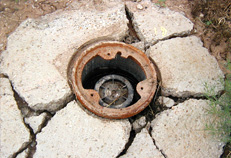Contamination of Groundwater
The Committee considers groundwater contamination to be the detrimental alteration of the naturally occurring physical, thermal, chemical, or biological quality of groundwater.
There are several ways groundwater can be contaminated. The most common avenues for groundwater contamination are:
- Unplugged abandoned wells
- Well integrity issues, such as poor construction or design, age, negligent maintenance and faulty location (near septic tank)
- Non-point sources (pollution that originates from different sources and cannot be traced to any single point such as a pipe)
- Improper use, disposal or releases of contaminants (motor oil, cleaners, pesticides, etc.)
- Flooding
To learn more, see the following links:
- The Groundwater Foundation's:
- Groundwater Contamination webpage
- "Protecting Our Water: A Primer for Preventing Pathogenic Contamination of Drinking Water Sources", available on their Tools & Resources webpage
- U.S. Geological Survey's (USGS) National Assessment of Volatile Organic Chemicals in Major Aquifer Systems and Rivers contains data and reports
- USGS National Water-Quality Assessment (NAWQA) Pesticide National Synthesis Project
- USGS's Water Science School: Groundwater
- TGPC's Groundwater as Drinking Water
- Texas Commission on Environmental Quality and Texas State Soil and Water Conservation Board's Texas Nonpoint Source Program Annual Reports
- The National Ground Water Association and Ground Water Protection Council have produced a water-testing brochure for household water well owners living near oil and gas development and completion activities, including hydraulic fracturing.
- The Federal Emergency Management Agency, Florida Department of Health, Minnesota Department of Health, Virginia Tech Cooperation Extension, Texas A&M AgriLife Extension Service, and Texas Commission on Environmental Quality have produced How to Disinfect a Private Well System for private water well owners after their water well has been flooded; additional translations are also available.
The Texas A&M AgriLife Extension Service on-line Bookstore offers a number of publications on drinking water contamination (e.g., lead, arsenic, copper, nitrates, radionuclides, etc.), as well as introductory fact sheets such as "Solving Water Quality Problems in the Home" (L-5450) and "What's In My Water?" (E-176). Hard copies or free electronic downloads of these publications are available after setting up an account.







